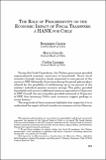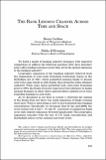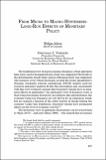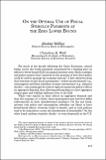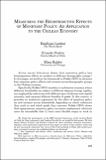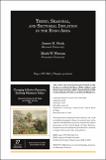Buscar
Mostrando ítems 61-70 de 323
How important is the commodity supercycle?
World commodity prices are known to display long cycles. These cycles have a periodicity of 20 to 30 years and are called commodityprice supercycles. Figure 1 displays the time paths of eleven commodity prices deflated by the U.S. consumer price index over the period 1960 to 2018. All commodity prices ...
Sovereign-Debt Crises and Floating-Rate Bonds
The choice of sovereign-debt maturity in countries at risk of default represents a complex set of competing forces. The tradeoffs reflect the underlying frictions present in international sovereign-debt markets. The primary frictions are the lack of state contingency in debt contracts and the inability ...
Managing an energy shock: fiscal and monetary policy
Prepared for the Proceedings of the XXV Annual Conference of the Central Bank of Chile, held in November 2022. We are grateful for helpful comments and suggestions from Jenny Chan, Sebastián Edwards, Jordi Galí, Peter Ganong, Pierre-Olivier Gourinchas, Jonathan Heathcote, Oleg Itskhoki, Enisse Kharroubi, ...
KFstar and portfolio inflows: a focus on Latin America
Policymakers faced with volatile capital flows may desire a method to identify the level of flows likely to persist in the medium
run. In a series of papers (Burger, Warnock, and Warnock, henceforth BWW, 2018, 2022), we have developed an estimate of the natural or equilibrium level of capital flows ...
The role of progressivity on the economic impact of fiscal transfers: a HANK for Chile
During the Covid-19 pandemic, the Chilean government provided unprecedented economic assistance to households. Direct fiscal transfers through stimulus checks amounted to nine percent of the country’s GDP. Aditionally, three times during the period, policymakers allowed for the possibility of withdrawing ...
The bank lending channel across time and space
We build a model of banking industry dynamics with imperfect competition to address the following question: How does monetary policy affect lending outcomes across time, given the spatial expansion of the banking industry?
Geographic expansion of the banking industry followed from the elimination ...
From micro to macro hysteresis: long-run effects of monetary policy
The traditional view of macroeconomic dynamics is that aggregate time series can be decomposed into a long-run component (the trend, or the deterministic steady state) and an orthogonal short-run component (the business cycle) which fluctuates around the trend. Quantitative dynamic stochastic general ...
On the optimal use of fiscal stimulus payments at the zero lower bound
For much of the decade following the Great Recession, central banks across the world remained constrained by a binding zero (or
effective) lower bound (ZLB) on nominal interest rates. Much academic and policy interest thus centered on the question of how fiscal policy could be used to manage the ...
Measuring the redistributive effects of monetary policy: an application to the chilean economy
Active recent literature shows that monetary policy has heterogeneous effects on workers in different demographic groups.1 In this paper, we build on the framework in Rubbo (2023) to estimate how monetary policy affects real incomes across demographic groups
in the Chilean economy.
Specifically, ...
Trend, seasonal, and sectorial inflation in the Euro Area
A central focus of monetary policy is the underlying rate of inflation
that might be expected to prevail over a horizon of one or two years.
Because inflation is estimated from noisy data, the estimation of
this underlying rate of inflation, which we refer to as trend inflation,
requires statistical ...


